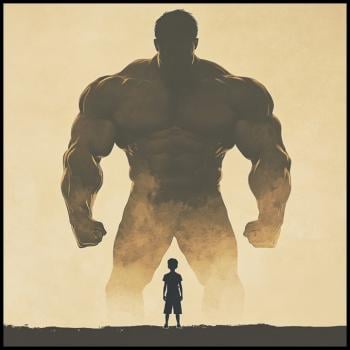
In 70 AD, the city of Jerusalem was surrounded by the Roman army. After many days of intense battle, the Romans broke down the gates, swarmed through the city and slaughtered men, women, and children. It was, according to the historian Josephus (who was an eyewitness to the entire bloody event) one of the most horrific displays of violence the world had ever seen.
Here’s a short excerpt from Josephus’s account:
“…As they [Roman soldiers] drew closer to the Temple, they pretended not even to hear Caesar’s orders, but urged the men in front to throw in more firebrands.
“Most of the slain were peaceful citizens, weak and unarmed, and they were butchered where they were caught. The heap of corpses mounted higher and higher about the altar; a stream of blood flowed down the Temple’s steps, and the bodies of those slain at the top slipped to the bottom.
“While the Temple was ablaze, the attackers plundered it, and countless people who were caught by them were slaughtered. There was no pity for age and no regard was accorded rank; children and old men, laymen and priests, alike were butchered; every class was pursued and crushed in the grip of war, whether they cried out for mercy or offered resistance.
“Through the roar of the flames streaming far and wide, the groans of the falling victims were heard; such was the height of the hill and the magnitude of the blazing pile that the entire city seemed to be ablaze; and the noise – nothing more deafening and frightening could be imagined.
“The Temple Mount, everywhere enveloped in flames, seemed to be boiling over from its base; yet the blood seemed more abundant than the flames and the numbers of the slain greater than those of the slayers. The soldiers climbed over heaps of bodies as they chased the fugitives.”
References: Josephus‘ account appears in: Cornfield, Gaalya ed., Josephus, The Jewish War (1982); Duruy, Victor, History of Rome vol. V (1883).
With all of this fresh in my mind, I re-read Revelation Chapter 21 and 22 where John describes the New Jerusalem for us and I realized something so profound: Everything John tells us about the New Jerusalem is an inversion of what happened to the Old Jerusalem.
In John’s description of the New Jerusalem, the enemies of Christ are outside the walls of the city, but there are no gates for them to tear down. Instead, we are told that the gates of the New Jerusalem “will never be shut.” [v.25]
Also, in the center of the New Jerusalem, John tells us “I saw no temple in the city, for the temple is the Lord God Almighty, and the Lamb” [v.22]. Instead of those Nations [who are the enemies of Christ] bringing death into the City to destroy the temple, they are welcomed into the City by the Temple Himself to receive healing and life as Jesus calls out to them saying, “To the thirsty I will give to drink from the spring of the water of life without payment.” [v.6]
Whereas the Armies of Rome broke down the gates to burn down the Temple and spread death in the Old Jerusalem, in the New Jerusalem the Armies outside the City find the gates wide open, and they are offered waters of life to drink, and abundant life is freely given to them; even the trees that grow along the river “are for the healing of the Nations” [Rev. 22:2]
Then I noticed the significance of this verse and saw it as if for the first time:
“The Spirit and the Bride say, “Come.” And let the one who hears say, “Come.” And let the one who is thirsty come; let the one who desires take the water of life without price.” [Rev. 22:17]
To whom are the Spirit and the Bride saying “Come”? I used to think we were calling out to Jesus to “Come quickly!” and rapture all of us to this New Jerusalem. But I don’t think this makes sense in context. [That comes later in the chapter]. Notice that after that it says: “And let the one who is thirsty come; let the one who desires take the water of life without price.”
Who would that be? Not Jesus. But those outside the city gates, who are in torment, “those who hear” and “those who are thirsty” are being wooed by the Spirit and the Bride to come and “take the water of life without price.”
All of his made me ask: “What if this picture of the New Jerusalem isn’t meant to tell us about an actual future event after the end of time?” I wondered, “What if this picture of New Jerusalem is intended to redeem the horrific destruction of Old Jerusalem?”
What if this is really the entire point that John is trying to make? That God’s intention is to subvert all the violence of AD 70 and, in Christ, to reframe the dark violence against Old Jerusalem as a triumphant display of mercy and grace in the New Jerusalem?
Isn’t this also a picture of what Christ did on the cross? Isn’t this also how Christ absorbed all the violence of the Roman crucifixion – which was intended to bring great shame upon the victims – and redirected all of it to shame the principalities and powers?
As Paul phrases it: “[God ] disarmed the rulers and authorities and put them to open shame, by triumphing over them in [Christ].” (Col. 2:15)
They sought to shame Christ by nailing Him to a cross, but instead, Christ disarms them and exposes them to shame, but then He does something even more marvelous – He forgives their sin and absolves them of murder saying, “Father, forgive them. They don’t know what they’re doing.”
I think this is exactly what John wants us to see in Revelation 21 and 22. The Romans, whose armies were made up of people from every tongue, and tribe and nation that their Empire had conquered, surrounded the Old Jerusalem, broke down the walls, torched the Temple and exhaled violence and death upon everyone in that city.
Now, Christ has established a New Jerusalem, and when His enemies – made of people from every tongue and tribe – come to storm the gates and destroy the Temple, they find the gates wide open, and instead of a Temple they see a Lamb standing in the center of the City inviting them to drink freely from the waters of life, and to receive healing for their wounds.
In the New Jerusalem, there is not death, but life; not destruction, but healing; not vengeance but forgiveness; not darkness but light.
Do you know another name for this New Jerusalem? John also says that it is called “The Bride of Christ.” [Rev. 21: 9-10]
And who is the Bride of Christ? We are the Bride of Christ.
So, this is our mission. This is our story. This is who we are.
“Let the Spirit and the Bride say ‘Come!'” to those outside the city walls who are thirsty for the waters of life.
Come, drink deep. It’s on the house.
-kg
**
Keith Giles is the author of “Jesus Untangled: Crucifying Our Politics To Pledge Allegiance To The Lamb” and co-host of the Heretic Happy Hour Podcast.













